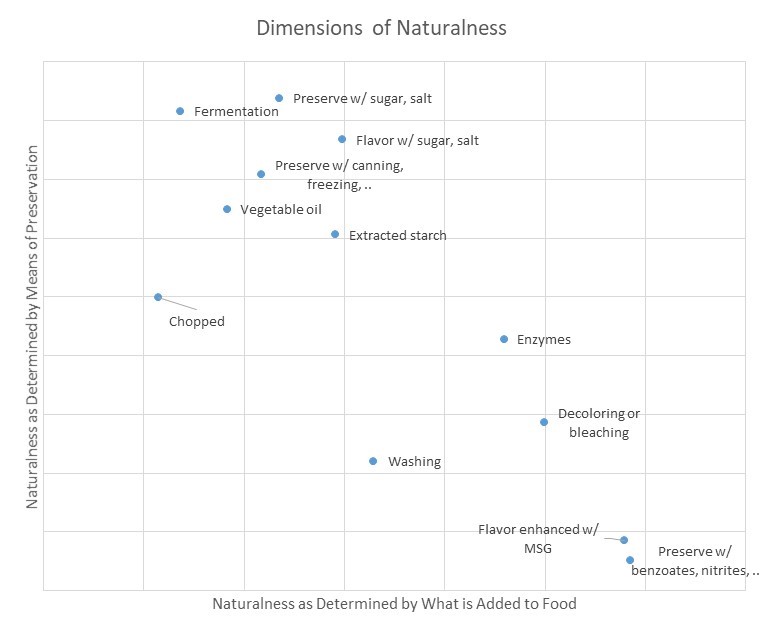Last week I wrote about a study I conducted on how consumers think about the word “natural.” As a part of the same project, I also delved into consumer’s perceptions of the word “healthy.”
“Healthy”, at least as a food package claim, has been defined by the FDA since 1993 by reference to total fat content, with changes made in 2016 to discriminate between different types of fat. Recently, however, the FDA has begun a process to potentially re-define the term, suggesting the need for more information on consumer’s current perceptions of the term and labeling claim.
One of the first questions on this topic I asked my sample of over 1,200 nationally representative food consumers was an open-ended question: “What does it mean to you for a food to be called ‘healthy’?” A word cloud constructed from the responses is below (the full report is available here). Words like good, fat, nutrition/nutrient/nutritional, natural, sugar, calorie, and organic were most commonly mentioned. Responses provided some support for current FDA definition as “fat” is one of the most commonly mentioned words (mentioned by 10.4% of respondents), although nearly as many (6.6%) mentioned sugar. More than a quarter of respondents provided imprecise or tautological-like definitions like “good ingredients,” “good for you,” or “healthy ingredients.”
In addition to the open-ended question on the meaning of “healthy”, respondents were provided with a list of 13 factors that consumers might use to judge whether a food is healthy. The figure below shows that about a quarter of respondents indicated sugar content and use of hormones or antibiotics, 19.2% pointed to fat content, and 18.4% pointed to pesticide residues. The top four answers included two nutrients (sugar and fat) and two food production processes/ingredients (hormones and pesticides), suggesting consumers consider healthiness to be more than just defined by nutrient content. However, it should be noted that hormones and pesticides were infrequently mentioned (both mentioned by less than half a percent of respondents) when unaided.
To further explore how consumers define and think about healthiness, a couple binary choice questions were posed. Consumers were about evenly split on whether a food can be deemed healthy based solely on the foods’ nutritional content (52.1% believing as such) or whether there were other factors that affect whether a food is healthy (47.9% believing as such). Consumers were also evenly split on whether an individual food can be considered healthy (believed by 47.9%) or whether this healthiness is instead a characteristic of one’s overall diet and the combination of foods consumed (believed by 52.1%). These responses suggests difficulty in creating a definition of “healthy” on food packages that is broadly acceptable to consumers. Answers to these two questions are not determinative of each other, but rather there are four distinct consumer segments with regard to healthy food conceptions. The figure below indicating the percent of respondents who answered these two questions in the four possible manners.
Respondents were also provided a list of 15 foods in random order and were asked to indicate whether each was healthy, unhealthy, or neither healthy nor unhealthy. For each item, a healthiness score was created by subtracting the percent of respondents who considered a process unhealthy from the percent of respondents who considered a process healthy. The figure below shows the results.
Almost all respondents (96.2%) considered fresh vegetables to be healthy, and almost none (0.9%) considered them unhealthy, yielding a net healthy score of 96.2-0.9=95.3% for fresh vegetables. Fresh fruit, fish, eggs, and chicken were likewise broadly considered healthier than not. Frozen vegetables/fruit were considered less healthy than fresh, and canned were considered less healthy than frozen, although even canned was considered, on net, more healthy than unhealthy. Only three of the 15 items listed were considered by more respondents to be unhealthy than healthy: vegetable oil, bakery and cereal items, and particularly candy.
To explore how consumers conceptualized the healthiness of different foods, the questions used to create the figure above were further analyzed using factor analysis. The first factor, shown on the vertical axis of the following figure shows all animal products with high values and other non-animal products with lower values, suggesting consumers use animal origin as a primary factor in judging whether a food is healthy. Another factor illustrated on the vertical axis, indicates freshness or degree of processing is another dimension to healthiness evaluations. These results indicate that healthiness is not a single unifying construct, but rather consumers evaluate healthiness along a number of different dimensions or factors. A food, such as beef or fish, can be seen as scoring high in some dimensions of healthy but low in another.
Respondents were asked to indicate their extent of agreement or disagreement with eight statements. The highest levels of agreement were with the statement, “Individual needs determine whether various foods are healthy for an individual.” Only 7.8% of respondents disagreed with this statement, whereas more than 70% agreed with it. There were also strong beliefs that healthy food is safe to eat and natural. There was only moderate agreement that healthier food is tastier. About 44% of respondents neither agreed nor disagreed with this statement. There was slightly more disagreement than agreement that healthy food is more convenient to eat. A majority of consumers (58%) disagreed that healthy is more affordable.
There is a lot more in the full report.













